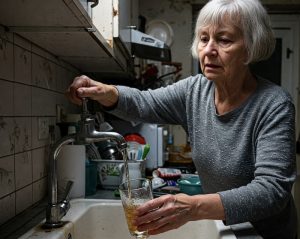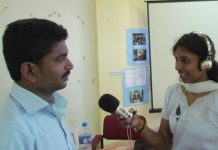 Impactful and original journalism often begins with the answer to a question which, after thorough investigation, develops into a news story with significant implications.
Impactful and original journalism often begins with the answer to a question which, after thorough investigation, develops into a news story with significant implications.
The amount of effort a journalist puts into that investigation will define how strong the story becomes.
The following is a fictitious scenario where a reporter stumbles across a potential story and turn it into a major news item with far-reaching consequences.
We follow the process from the reporter’s initial curious enquiries through to publication and multiple follow-ups.
Not all the steps will be relevant to all stories. Every story is different, so please view the following as a practical guide.
So let’s look at the possible evolution of an original news story.
‘Water woes in Weston’
Reporter: You
Newspaper: The Weston Herald
Type of story: Investigative
Topic: Public Health
Setting: The fictional town of Weston
Overview
In this fictional case study you are a local newspaper reporter who stumbles across a story. You then use all the journalistic tools at your disposal, including traditional reporting techniques, fact-checking, social media input, artificial intelligence (AI) tools, data journalism, and computer-assisted reporting (CAR) to build a high-impact public interest story.
Stage 1: Story discovery
At a routine meeting of Weston City Council you find that you are one of three journalists sitting at the press (media) desk in front of the councillors.
As the meeting nears the end the chairperson says the agenda is finished and asks if there is any other business.
An elderly woman stands up and starts shouting. It’s not clear what the issue is, but she mentions the word ‘water’ before she is asked to sit down by a council official and the meeting ends.
The woman shuffles out of the public gallery muttering and you follow. The other two journalists brush past and leave the building. You ask the woman if she is okay and offer her a drink of water. She is clearly still upset so you suggest she sits down.
The woman starts to tell you about how discoloured water that smells of rust is coming
out of her kitchen drinking water tap. She says she has suffered stomach cramps as a result.
She tells your that “dozens of people” throughout the whole area have been suffering from stomach pains and digestive disorders for months. You decide to investigate further.
Your response:
- Interview the woman taking her name and address and making a note of any symptoms she has been experiencing.
- Ask her if it would be okay to visit her and talk to her neighbours?
- Decide it’s an important health and public services infrastructure story
- Discuss with the editor (referring up) to assess the strength of the story and whether The Weston Herald has the resources to investigate further.
- Once you have the editor’s approval, continue to stage 2.
Stage 2: Verification
Back in the newsroom, you begin to check what you have been told in order to determine whether the woman’s account is factual and, if it is, whether this is a one-off incident or part of a bigger issue.
See: Fact-checking and adding context
Your actions:
- Search recent water quality reports on Weston City Council’s public health website where you find vague mentions of “scheduled maintenance.”
- Visit the neighbourhood concerned to call on the woman and try to interview any neighbours who can back up her claims then ask their permission to quote them.
- If possible take photographs, record videos and voice recordings.
- Take a sample of the drinking water for examination.
- Call the local water utility company where you receive a cautious, generic response – they promise to email a statement.
- File a Freedom of Information (FOI) request for water quality test results from the past year.
- Contact the local councillor for the area and arrange an interview.
- Visit the city’s walk-in clinic, where a nurse is willing to speak off the record and mentions a recent increase in stomach complaints from the area concerned.
Your gut feeling is that the issue is bigger than civil servants and some politicians at city hall want to admit. Now you have verification, continue to stage 3.
Stage 3: Digital research & AI-assisted investigation
To understand the broader scope, and in order to check whether this issue has surfaced publicly, you turn to digital tools and artificial intelligence (AI).
Social media monitoring
You use advanced keyword searches and hashtags such as #WestonWater and #BoilAlert across the most popular social media platforms. In doing so you discover:
- A viral video posted by a college student showing cloudy, sediment-filled water.
- Multiple posts with photos of brown water and bottled water deliveries to homes in the affected area.
- Photographs and videos of taps with brownish-coloured water flowing out.
See: Social media in news production and news dissemination
Your actions:
- Message posters to confirm dates, locations, and to seek permission to use the content or quotes.
- See: Respecting privacy
- Scan the Weston Facebook group, a sub-Reddit chat group, and a local public discussion forum called ‘Weston Life’. You discover that:
- Residents have been reporting issues for more than a year.
- Many claim to have called the city several times but got no response.
- Dozens have written in the forums about sickness, listing their symptoms, and asking advice.
- A large number have been forced to take days off sick, losing pay and facing other financial costs – such as having to buy bottled water.
AI tools for journalists
You decide to turn to the newsroom-approved AI tools to:
- Create a prompt asking AI to help you in your research.
- Summarise hundreds of resident complaints into thematic clusters (odour, colour, illness) then feed that into AI.
- Extract mentions of “pipeline repair” and “test failure” from scanned PDFs of city council minutes.
- Generate questions you hadn’t considered by asking AI questions such as “have you any further information or are there any topics I have missed”
- Ask specific questions such as “were local schools affected?” and “what should people do if they feel unwell.”
- See:
Online search
Extend your online search to local blogs, archived news, and school newsletters. As a result you find an overlooked article from the previous year about postponed infrastructure upgrades to the town’s water system.
You now have a timeline, a cluster of impacted locations, and proof that the issue has persisted, and appears to have been ignored, for at least a year. You also have several follow up ideas generated by AI.
Now you have a rundown on what local residents say they have experienced. Time to move on, continue to stage 4.
Stage 4: Building the evidence
With multiple red flags raised, you then launch a deeper investigation that combines interviews, source cultivation, and data analysis using Computer Assisted Reporting (CAR) techniques.
Your actions:
- Interview a local environmental scientist, who explains how E. coli can enter municipal water systems through cracks in ageing pipework.
- Speak confidentially with a whistleblower – a former contractor who had posted in one of the local forums you have been monitoring. The whistleblower claims the city has had at least two “bad” water tests marked as anomalies.
- Get a city council member to confirm (off the record) that internal concerns were raised but ignored due to budget delays.
- Find a science student at the local university who is prepared to examine the drinking water sample you obtained when you visited local residents in the affected area.
- You discover that E. coli is present in the sample you took.
- Establish who is responsible, the council for the poorly maintained pipework or the water authority for not dealing the the contamination and allowing E. coli to infect the drinking water.
Data journalism & CAR
You now need hard data to back up the story, and you need to find a way of using that data to uncover more facts about the water quality. So you:
- Use a tool such as Tabula to extract data from publicly available city council PDFs
- Check the open data websites for relevant material
- Clean and organise the three years of data you have already gathered using a tool such as OpenRefine
- Create pivot tables in a spreadsheet in order to identify elevated E. coli levels in the two neighbourhoods that were mentioned in the public discussion forums
- See:
Health data cross-check
You request anonymised clinic visit data using neighbourhood postal codes. You find patterns regarding spikes in gastrointestinal illness correlate closely with failed water tests. You then use spreadsheet analysis and pivot tables to match dates and locations.
Interactive mapping
You then build a geographic visualisation using tools such as Google My Maps and Tableau Public to map:
- Resident complaints
- Water test results
- Utility service outages
The visual shows you that there is a hotspot emerging centred on the same streets and in the same time frames.
Follow the money
You then dig through public records and find that the city allocated funds to upgrade the water main last year, but the project was postponed twice.
You create a timeline graphic showing that funding delays align with water test failures and health complaints.
You now have solid data sets with graphics, visuals, maps and tables containing the information you need to continue to stage 5.
Stage 5: Newsroom collaboration & legal check
At The Weston Herald’s next editorial meeting you present your findings. Your colleagues are shocked and excited. The story is chosen by the editor as a Sunday front-page feature.
You work with:
- A graphics team to produce the timeline and interactive map.
- A photojournalist to capture images of bottled water handouts, corroded pipes, and worried residents.
- The legal team, who reviews the language around whistleblower claims and statements about city negligence.
Beyond fact-checking
- You now need to assess any new information that has come to light,
- See:
- You need to sift through the information you have to identify fake-news, rumour, gossip, misinformation and disinformation.
- See:
Now your investigation has been commissioned you will have been given a deadline. You now move to stage 6.
Stage 6: Story production – multimedia journalism
You write a 1,200-word investigative feature: ‘Something in the water: Weston’s hidden health crisis’
The story package includes:
- Top story: The main feature with data visualisations, maps, and charts.
- A sidebar: ‘How to get your water tested in Weston’
- An explainer: ‘What Is E. coli and how does it enter water systems?’
- A three-minute video segment where you summarise your investigation.
- An interactive timeline showing test failures, health complaints, and city inaction.
Ethical journalism
Before publishing make sure everything you have produced meets the highest ethical standards.
- See:
Tone and language
You need to make sure that all the content you produce is created to meet the needs of your target audience and that it is produce in the right tone and language.
- See:
You now have the material required to present to the editor. It is given the green light, continue to stage 7.
Stage 7: Publication and public response
The story is on the newsstands and live on the Weston Herald website on Sunday morning. By Sunday night, it’s the top-trending topic in the region.
What happens next:
- The mayor calls a news conference announcing an emergency audit of the water system.
- The city begins delivering bottled water to affected areas.
- Schools switch to bottled water dispensers.
- You host a live Q&A (question and answer session) on The Weston Herald’s YouTube channel and appear on local radio and regional TV stations to explain your story.
- You then set to work on a follow-up piece.
A week later, The Weston Herald publishes your follow-up piece:
“City begins pipe replacement after Herald investigation”
So the piece has been published, the follow up was informative and well-received, but there is still work to do. Continue to stage 8.
Stage 8: Forward planning – keeping the story alive
Even after the initial public response and government action, you know the story is far from over. The contaminated water crisis in Weston is not a one-day headline, it’s the beginning of an evolving public health and infrastructure story.
You want to ensure the newsroom stays on top of the story, so you proactively prepare for further follow-up reporting.
Your actions:
- Add the story to the newsroom’s planning diary, flagging it for a revisit in three months, and schedule reminders for yourself and the editor.
- Draft a follow-up memo outlining five potential angles to explore, each one deserving its own article or series.
- See:
- Proposed follow-up angles such as:
- Long-term health effects – Are there lingering health concerns among residents? Have doctors seen lasting symptoms? Are children more affected?
- Ageing infrastructure – What is the broader state of the town’s pipes, pumps, and public systems? Is Weston alone, or is this a regional issue?
- Cost of replacement – How much will the water system fix actually cost? Who’s paying, the residents, the city, or regional aid? What will bills look like?
- Accountability & transparency – Who knew what and when? Did city officials hide key reports? What’s the outcome of the promised audit?
- Emergency preparedness & risk communication – Why wasn’t there an advisory telling local residents to boil their drinking water? How is the city preparing for future crises? And how will residents be warned?
Role of the forward planning editor
You talk to the forward planning editor, who plays a vital role in:
- Logging story updates in the news diary/calendar software.
- Tracking city council meetings, audit deadlines, and infrastructure contract milestones.
- Assigning you (or other reporters) to timely follow-ups as new data or events unfold.
- Ensuring the newsroom doesn’t drop the story after initial publication.
- Working with visuals and data teams to prepare ongoing visuals, dashboards, or story trackers.
- See:
In the meantime…
While waiting on audit results and health studies, you continue to report smaller sidebars and updates:
- A short Q&A with a local plumber about corrosion in household pipes.
- A piece on how residents are organising to test their own water.
- A weekly visual showing how much pipe replacement work has been completed.
This strategy helps you to build your specialism around the issue, grow your expertise, and deepen trust with readers. You might be on your way to becoming a specialist.
But you soon realise that the topic is far too big for your to cover on your own, and The Weston Herald doesn’t have the resources available to put more staff on the story. So you move to stage 9.
Stage 9: Collaborative journalism
As the water crisis unfolds and more implications emerge, you realise that The Weston Herald might not be able to cover every angle alone. The story has grown beyond local plumbing, it’s about systemic failures in public infrastructure, regional health inequalities, and government oversight.
To pursue this more comprehensively, your newsroom begins working with other trusted local media outlets as part of a collaborative investigative effort.
Why collaborate?
- The story affects multiple neighbouring towns and municipalities.
- Other outlets have different expertise. One has better political sources, another a strong data team.
- Pooling resources allows greater reach, more time, and stronger accountability.
- It reduces duplication and helps avoid story fatigue by sharing the load.
How the collaboration works:
- Shared document hub – The team at The Weston Herald sets up a secure shared workspace (e.g., Google Drive, Airtable, or a tool like DocumentCloud).
- Weekly editorial calls – Reporters and editors from participating outlets meet virtually to share leads, coordinate angles, and set deadlines.
- Role specialisation – The Weston Herald leads on health and community response. Metro Daily investigates state infrastructure contracts. North County Chronicle digs into regional water testing irregularities, Radio Weston gathers ongoing audience concerns through its phone-ins, and the Weston Tonight TV show continues to gather video footage.
- Data & FOI pooling – All five outlets share FOI requests and data scraping tools to maximise impact while removing duplication.
- Joint publication agreements – Stories may be co-published or staggered for reach. All credit is shared.
Outputs from the collaboration:
- A multi-part investigative series:
- “Pipes, politics, and the price of silence: How an aging water system failed a region”
- A centralised public data dashboard tracking:
- Testing schedules
- Illness reports
- Pipe replacement progress across the county
- Region-wide reaction, with policymakers referencing the series in committee hearings.
What you discover:
- No one newsroom can uncover everything.
- Collaborations break down silos and bring stronger checks on power.
- Shared reporting builds trust – not just between journalists, but with audiences who see consistency and follow-through.
- By joining forces with other print and online outlets as well as TV and radio broadcasters you create a new multimedia dynamic which encompasses the specialist skills and audience focus of each outlet
Bonus outcome:
The collaboration earns recognition from a regional media watchdog, and you are invited to speak on a panel about the power of local media partnerships in the public interest.
Now is the time to take a step back, review what has been done, and plan for the future. It’s time for stage 10.
Stage 10: Legacy & long-form – preserving the story, extending the impact
After months of coverage, collaborative investigation, and associated consequences, you and your editors reflect on what this story has become: not just a local exposé, but a watershed moment for Weston and surrounding communities.
To ensure the story’s long-term accessibility, The Weston Herald takes bold steps in digital curation and storytelling legacy.
Digital archiving: A special website section
- The newsroom creates a dedicated microsite within its main website called: “The water files: a Weston crisis”
- What the special section includes:
- The complete series of all your reporting (including collaborative and follow-up pieces).
- Interactive maps, charts, and timelines.
- Embedded video explainers and community interviews.
- Behind-the-scenes notes on how the investigation unfolded.
- A real-time ‘story tracker’ showing promised actions by city officials and their status (complete, pending, unresolved).
This section becomes a go-to resource for teachers, policymakers, activists, and citizens.
Publishing ambitions: turning journalism into a book
With the story’s depth, scale, and regional relevance, your editors begin exploring the idea of turning the reporting project into a book which would be a documented public history of the water crisis.
Goals for the book:
- Create a narrative nonfiction account that preserves the chronology, tension, and stakes.
- Include your field notes, FOI documents, and community voices.
- Partner with an independent publisher or crowdfund to cover production costs.
- Ensure the final product is accessible to schools, libraries, and universities.
- Offer a journalistic document of record that outlives the news cycle including important archived material.
- See:
You are approached to co-author the book, possibly with another collaborator from the multi-newsroom effort. You start working on a proposal and outline, supported by your editor and legal team.
Why it matters:
- Stories of public failure and civic resilience deserve to be preserved, studied, and shared.
- A book provides not just information, but accountability, transparency, and memory.
- It reinforces journalism’s role in shaping history, not just reacting to it.
- it adds to The Weston Herald’s brand strengths as an outlet to be trusted.
- See:
- Proceeds from any book sales could be partly donated to local water safety education programmes or used to fund further local investigations thereby cementing The Weston Herald’s value to the community.
With this added, your journey while covering the story now reflects the full spectrum of modern reporting, from solo discovery to cross-newsroom collaboration, from street-level interviews to spreadsheet analysis, and from a single concern to a system-wide reckoning.
Summary: A living story
Your original investigation triggered real change. But thanks to clear planning, data insights, and editorial foresight, the story doesn’t end when it’s published, it evolves.
Through smart use of the news diary, collaboration with the forward planning editor, and a sharp eye for new angles, you are able to keep the pre ssure on the council and the water company to do the job they are there to do – as well as keep the public informed, your audience, informed every step along the way.
Final takeaway: From tip to testament
Your original curiosity at a city council meeting evolved into:
- A major public interest scoop
- A digital knowledge hub
- A model of collaborative reporting
- And potentially, a published work that becomes part of Weston’s shared history.
This final step shows that journalism – when carried out with integrity, vision, and persistence – can live well beyond the headline.
Background reading
To get the most out of the story, the reporter needs to draw on skills covered in many articles on this site including:








